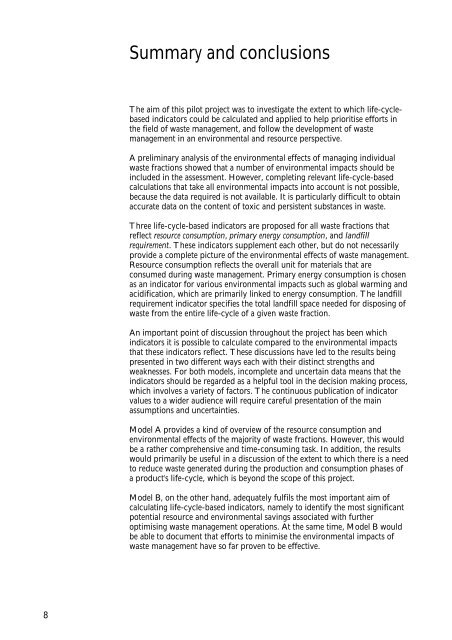Waste Indicators
Waste Indicators
Waste Indicators
Create successful ePaper yourself
Turn your PDF publications into a flip-book with our unique Google optimized e-Paper software.
Summary and conclusionsThe aim of this pilot project was to investigate the extent to which life-cyclebasedindicators could be calculated and applied to help prioritise efforts inthe field of waste management, and follow the development of wastemanagement in an environmental and resource perspective.A preliminary analysis of the environmental effects of managing individualwaste fractions showed that a number of environmental impacts should beincluded in the assessment. However, completing relevant life-cycle-basedcalculations that take all environmental impacts into account is not possible,because the data required is not available. It is particularly difficult to obtainaccurate data on the content of toxic and persistent substances in waste.Three life-cycle-based indicators are proposed for all waste fractions thatreflect resource consumption, primary energy consumption, and landfillrequirement. These indicators supplement each other, but do not necessarilyprovide a complete picture of the environmental effects of waste management.Resource consumption reflects the overall unit for materials that areconsumed during waste management. Primary energy consumption is chosenas an indicator for various environmental impacts such as global warming andacidification, which are primarily linked to energy consumption. The landfillrequirement indicator specifies the total landfill space needed for disposing ofwaste from the entire life-cycle of a given waste fraction.An important point of discussion throughout the project has been whichindicators it is possible to calculate compared to the environmental impactsthat these indicators reflect. These discussions have led to the results beingpresented in two different ways each with their distinct strengths andweaknesses. For both models, incomplete and uncertain data means that theindicators should be regarded as a helpful tool in the decision making process,which involves a variety of factors. The continuous publication of indicatorvalues to a wider audience will require careful presentation of the mainassumptions and uncertainties.Model A provides a kind of overview of the resource consumption andenvironmental effects of the majority of waste fractions. However, this wouldbe a rather comprehensive and time-consuming task. In addition, the resultswould primarily be useful in a discussion of the extent to which there is a needto reduce waste generated during the production and consumption phases ofa product's life-cycle, which is beyond the scope of this project.Model B, on the other hand, adequately fulfils the most important aim ofcalculating life-cycle-based indicators, namely to identify the most significantpotential resource and environmental savings associated with furtheroptimising waste management operations. At the same time, Model B wouldbe able to document that efforts to minimise the environmental impacts ofwaste management have so far proven to be effective.8
















